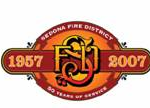 The Sedona Fire District has certified firefighters, who also possess levels of medical training and certifications up to paramedics. Their level of training and skills includes but is not limited to: Technical Rescue which involves high angle rope, trench, swift water, injured hikers, confined space, tower/bridge, and structural collapse. In addition to these types of incidents, the firefighters are also responsible for mitigating commercial and residential structure fire, wildland fires, hazardous material incidents, and many other hazardous situations.
The Sedona Fire District has certified firefighters, who also possess levels of medical training and certifications up to paramedics. Their level of training and skills includes but is not limited to: Technical Rescue which involves high angle rope, trench, swift water, injured hikers, confined space, tower/bridge, and structural collapse. In addition to these types of incidents, the firefighters are also responsible for mitigating commercial and residential structure fire, wildland fires, hazardous material incidents, and many other hazardous situations.
 To help understand what the mitigation these emergency responses require, I have provided some examples:
To help understand what the mitigation these emergency responses require, I have provided some examples:
Injured Hiker calls
Non-technical incidents require a patient being carried out with a stokes litter basket which is attached to a steel support base and rolls on a single large wheel. If the patient is on a trail and it is flat or low terrain, 6 firefighters can generally treat and transport the patient to the trailhead and place them into a staged Ambulance.
If the patient is located in an area with low to steep angles, the response requires 8-10 firefighters to remove the patient. This type of incident would become a longer time commitment. The more difficult to mitigate an incident, the more time is associated.
Technical Incidents (use of rope systems)
When victims go over cliffs on foot or in vehicles, the recovery becomes more challenging. Steep to high angle rescue requiring two-rope system adds time and personnel to the incident. These types of technical challenging incidents will call for 14-16 firefighters and becomes an extended operation. High angle rescues will also involve more time and specialized climbing personnel to mitigate the incident.
Swift water Response
Only the easiest of swift water rescue can be mitigated with a single engine company response. This would be accomplished reaching the victim with a long pike pole or a throw rope bag. All of our engines are equipped with personal floatation devices (PFD) and throw rope bags.
Most swift water rescues require 16 to 25 personnel to successfully achieve a rescue. The large number of rescuers is necessary to fill positions on this type of incident: upstream spotters, rescue teams on both sides of the creek, the in or on water rescuers, and downstream spotters. The firefighters also develop a downstream contingency plan due to the dynamic nature of these incidents. Our specialized vehicle S531 carries our swift water gear to mitigate these calls.
These examples of incidents require specialized equipment and extraordinarily trained firefighters to mitigate the emergencies with which they are challenged. The title “Firefighter” has become a standard label on the men and women in the fire service who certainly exceed their level of training and skills well beyond what is needed to just fight fires. This provides the Sedona Fire District residents and business owners with an all-hazard response capability, which assures a professional deployment to your 9-1-1 call.
Visit our website at www.sedonafire.org for more factual information.
Nazih M. Hazime, Fire Chief
Sedona Fire District

Dear Residents,
Thank you for your ongoing support.
Safety first!
Sincerely,
Nazih M. Hazime
Fire Chief
Sedona Fire District
928.204.8924
NHazime@sedonafire.org